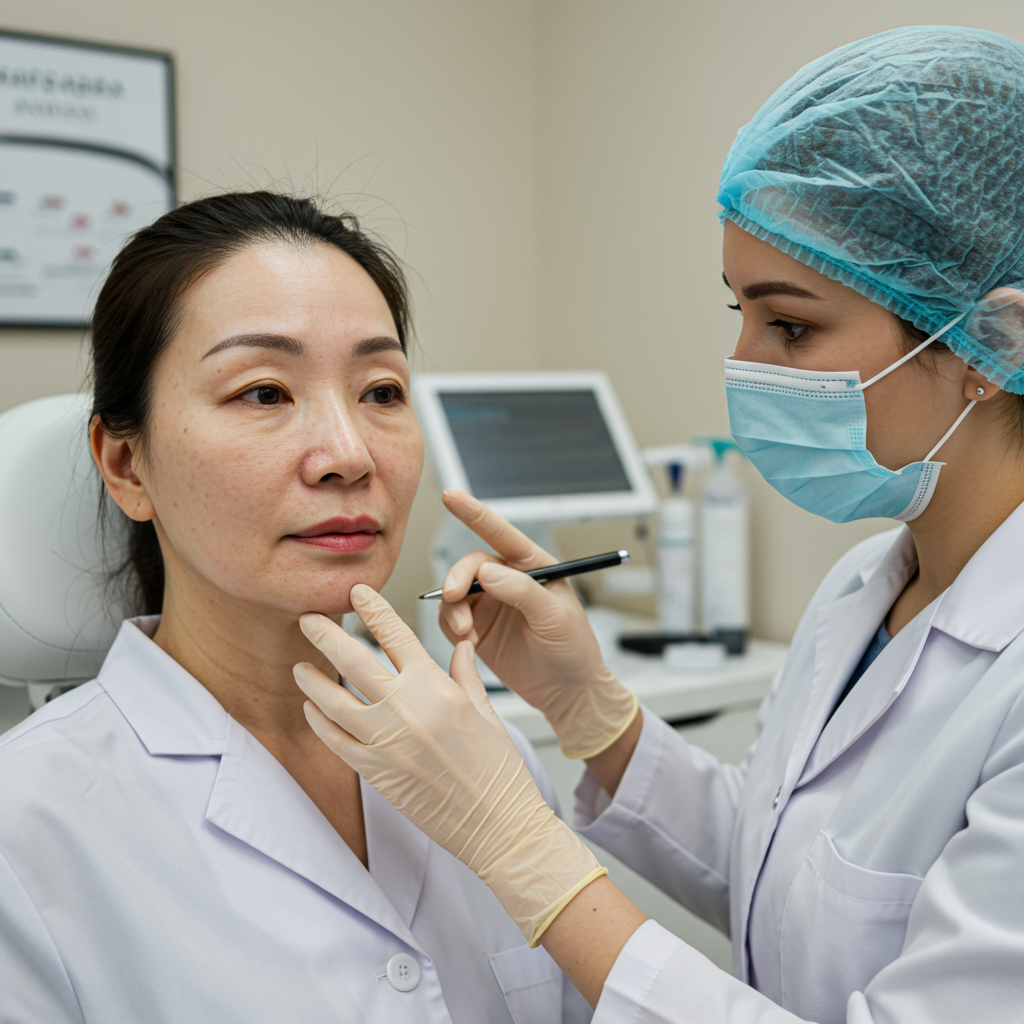Rapid weight loss, often triggered by popular GLP-1 medications like Ozempic and Wegovy, is leading to an unexpected aesthetic challenge for many individuals. This phenomenon, colloquially known as “Ozempic face,” describes the sudden facial volume loss and sagging skin that can emerge as fat diminishes from the face. As millions embrace these transformative weight loss drugs, a significant new trend is emerging: a marked surge in demand for cosmetic procedures designed to restore facial fullness and contour.
This unexpected side effect is now a growing focus for aesthetic specialists worldwide. Patients are increasingly seeking treatments to address the visible signs of rapid weight reduction, highlighting a crucial intersection between medical weight management and cosmetic intervention. Understanding this shift is vital for both potential GLP-1 users and those considering aesthetic enhancements.
Understanding the “Ozempic Face” Phenomenon
“Ozempic face” describes a distinctive appearance characterized by a hollowed, gaunt, or deflated look in the face. This occurs because the quick loss of significant body fat, while beneficial for overall health, doesn’t always allow the skin to adjust at the same pace. The fat pads that naturally provide youthful volume in the cheeks, temples, and around the eyes can diminish rapidly, leaving behind sagging skin and a more aged appearance.
Celebrity dermatologist Dr. Paul Jarrod Frank is credited with coining the term, observing a clear pattern among his patients. He notes that over 20% of his current clientele are now utilizing GLP-1 medications, often integrating them into broader “longevity regimens.” These patients frequently present with pronounced facial volume loss, necessitating multiple treatments. As Dr. Frank aptly puts it, “You can only refill a deflated balloon so much, and often surgical intervention is necessary.” This highlights the severity of the issue for some individuals.
The Surge in Aesthetic Treatments and Patient Journeys
The cosmetic industry is directly responding to this emerging patient demographic. Data from the American Society of Plastic Surgeons (ASPS) underscores this trend, reporting an 8% increase in facelift procedures between 2022 and 2023. Furthermore, the use of hyaluronic acid filler treatments has doubled since 2017, demonstrating a clear preference for non-surgical volume restoration. This significant uptick reflects a direct correlation with the rising popularity of GLP-1 medications.
Many individuals experience the effects firsthand. New Jersey resident Kimberly Bongiorno shared her experience after losing 45 pounds on Wegovy. “It looked like I had melted. It was horrifying,” she described, detailing her appearance before opting for a facelift and additional cosmetic procedures to restore her facial contours. Her story is a poignant example of the emotional and physical impact “Ozempic face” can have, driving individuals to seek professional aesthetic help.
Popular Cosmetic Solutions for Facial Volume Loss
Addressing “Ozempic face” often requires a tailored approach, combining various cosmetic techniques to restore a more youthful and natural appearance. The primary goal is to replenish lost volume and tighten lax skin.
Non-Surgical Volume Restoration
For many, the first line of defense involves non-surgical options that can effectively add volume and improve skin texture.
Dermal Fillers: Hyaluronic acid fillers are incredibly popular for their ability to plump specific areas. These injectables can strategically restore volume in the cheeks, temples, under-eyes, and jawline, softening hollows and creating a more refreshed look.
Biostimulatory Fillers: Beyond immediate volume, some injectables stimulate the body’s natural collagen production, offering longer-lasting improvements in skin elasticity and firmness over time.
Fat Grafting: This procedure involves harvesting fat from another part of the patient’s body (like the abdomen or thighs) and reinjecting it into the face. Fat grafting offers a natural and potentially permanent solution for volume loss, as the transplanted fat cells integrate with existing tissues.
Surgical Intervention for Advanced Cases
When significant skin laxity is present, non-surgical methods may not be sufficient.
Facelift (Rhytidectomy): For pronounced sagging and jowling, a facelift can be the most effective solution. This surgical procedure tightens underlying facial muscles, repositions fat, and removes excess skin, resulting in a more defined jawline and neck, and lifted mid-face contours.
Neck Lift: Often performed in conjunction with a facelift, a neck lift addresses loose skin and bands around the neck, further enhancing the overall facial rejuvenation.
Blepharoplasty (Eyelid Surgery): If rapid weight loss has caused hollowness or sagging around the eyes, eyelid surgery can remove excess skin or fat, or redistribute existing fat, to create a more alert and youthful eye appearance.
The Long-Term Outlook for GLP-1 Medications and Appearance
The long-term implications of GLP-1 medication use are an evolving area of medical study, particularly concerning sustained weight loss and its aesthetic consequences. Doctors are actively grappling with these complex issues. A critical point of consideration is patient adherence to these medications. Research indicates that a significant number of patients discontinue GLP-1 drugs within a year. For example, a University of Oxford study revealed that individuals typically revert to their original weight within 10 months of stopping the medication.
This potential for weight regain presents a unique challenge for both patients and aesthetic practitioners. If weight is regained after undergoing cosmetic procedures, the original aesthetic concerns might re-emerge, or new ones could develop. Dr. Steven Williams of the ASPS emphasizes this perspective: “We don’t want these patients to be on these medications for a lifetime. We want it to be a temporary bridge to a healthier lifestyle.” This sentiment underscores the importance of integrating GLP-1 use with sustainable lifestyle changes, including diet and exercise, to maintain weight loss and its aesthetic benefits long-term.
Navigating Weight Loss and Aesthetic Goals
For individuals considering or currently using GLP-1 medications for weight loss, a holistic approach is paramount. While the health benefits of weight reduction are undeniable, understanding the potential aesthetic changes and planning for them can prevent distress. It is crucial to engage in open discussions with both the prescribing physician and an experienced aesthetic specialist.
Before starting any weight loss medication, discussing potential effects on facial appearance can help set realistic expectations. For those already experiencing “Ozempic face,” a consultation with a board-certified plastic surgeon or dermatologist is the first step. These experts can assess the extent of facial volume loss and skin laxity, recommend appropriate non-surgical or surgical interventions, and develop a personalized treatment plan that aligns with individual goals and the broader weight management journey. Prioritizing skin health through proper hydration and skincare routines can also support overall facial vitality during weight loss.
Frequently Asked Questions
What causes “Ozempic face” and what does it look like?
“Ozempic face” is a term describing the facial changes that can occur with rapid weight loss, particularly seen in individuals using GLP-1 medications like Ozempic or Wegovy. It’s caused by the quick reduction of fat pads in the face, leading to a hollowed, gaunt, or sagging appearance. Common signs include sunken cheeks, more prominent wrinkles, a less defined jawline, and a general loss of youthful facial fullness, as the skin struggles to contract quickly enough to adapt to the volume decrease.
What types of cosmetic treatments are effective for “Ozempic face”?
Effective cosmetic treatments for “Ozempic face” depend on the severity of facial volume loss and skin laxity. Non-surgical options include dermal fillers, especially hyaluronic acid fillers, which restore volume in areas like the cheeks, temples, and under-eyes. Fat grafting, using the patient’s own fat, is another natural volume restoration technique. For more significant sagging, surgical procedures like facelifts are often recommended to tighten underlying muscles and remove excess skin, providing a more lifted and contoured result.
What should patients consider about the long-term use of GLP-1 medications and their impact on appearance?
Patients considering GLP-1 medications should understand the potential long-term implications, including aesthetic changes and the possibility of weight regain if the medication is stopped. Research suggests many patients discontinue GLP-1s within a year, with some returning to their original weight shortly thereafter. This means any cosmetic procedures performed to address “Ozempic face” might need re-evaluation or follow-up if weight fluctuates. It’s crucial to view GLP-1s as a “temporary bridge” to a healthier lifestyle that includes sustainable diet and exercise, ensuring weight stability for lasting aesthetic results.
Conclusion
The emergence of “Ozempic face” highlights a unique challenge in the era of rapid medical weight loss. While GLP-1 medications offer profound health benefits, their aesthetic consequences are driving a notable shift in the cosmetic surgery landscape. As more individuals experience significant weight reduction, the demand for procedures like facelifts and fillers continues to soar. Understanding this phenomenon, consulting with expert medical and aesthetic professionals, and planning for both the health and aesthetic aspects of weight loss are crucial. This ensures a holistic approach, leading not only to improved health but also to confidence and satisfaction with one’s appearance in the long run.




